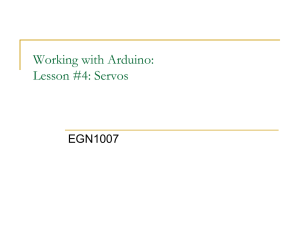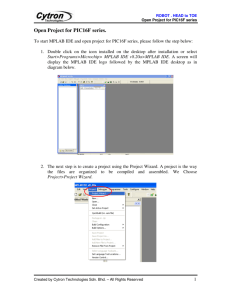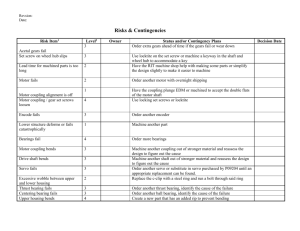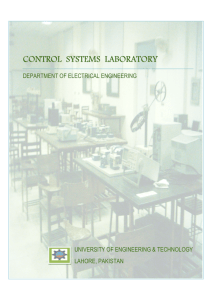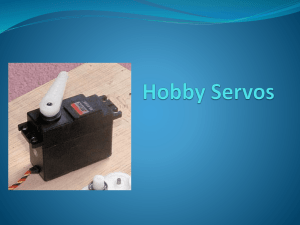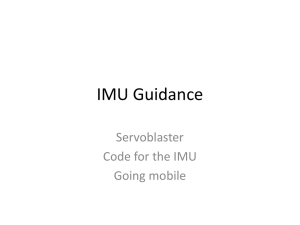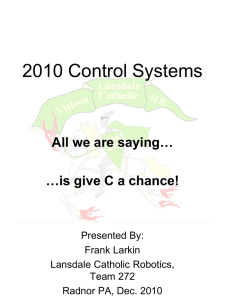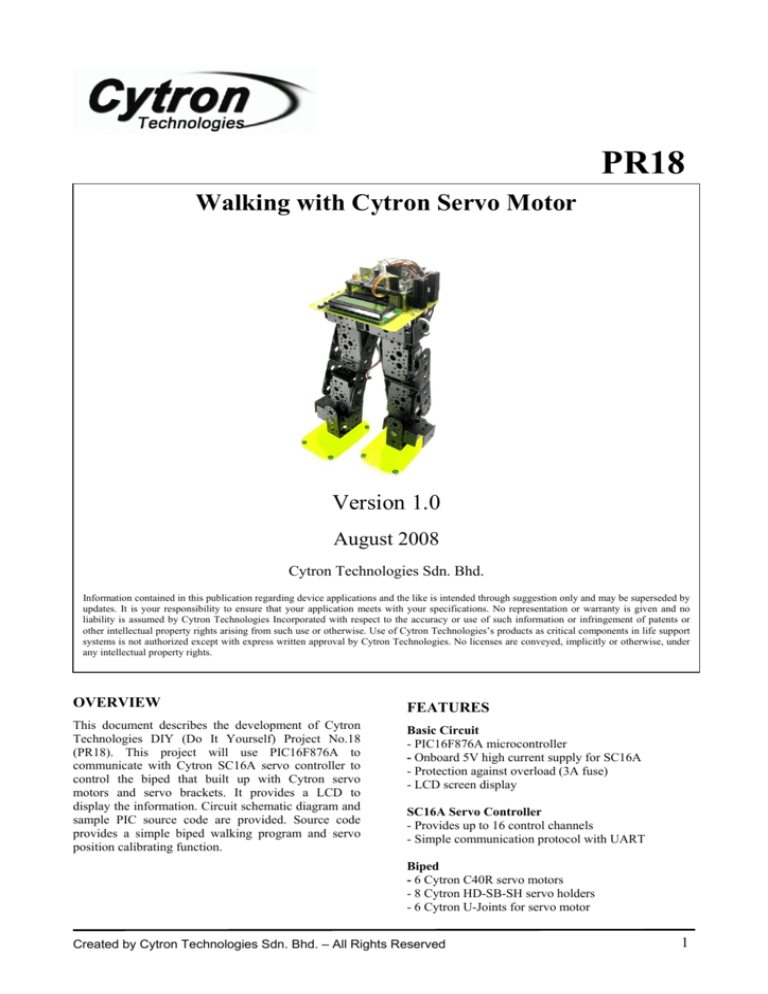
PR18
Walking with Cytron Servo Motor
Version 1.0
August 2008
Cytron Technologies Sdn. Bhd.
Information contained in this publication regarding device applications and the like is intended through suggestion only and may be superseded by
updates. It is your responsibility to ensure that your application meets with your specifications. No representation or warranty is given and no
liability is assumed by Cytron Technologies Incorporated with respect to the accuracy or use of such information or infringement of patents or
other intellectual property rights arising from such use or otherwise. Use of Cytron Technologies’s products as critical components in life support
systems is not authorized except with express written approval by Cytron Technologies. No licenses are conveyed, implicitly or otherwise, under
any intellectual property rights.
OVERVIEW
This document describes the development of Cytron
Technologies DIY (Do It Yourself) Project No.18
(PR18). This project will use PIC16F876A to
communicate with Cytron SC16A servo controller to
control the biped that built up with Cytron servo
motors and servo brackets. It provides a LCD to
display the information. Circuit schematic diagram and
sample PIC source code are provided. Source code
provides a simple biped walking program and servo
position calibrating function.
FEATURES
Basic Circuit
- PIC16F876A microcontroller
- Onboard 5V high current supply for SC16A
- Protection against overload (3A fuse)
- LCD screen display
SC16A Servo Controller
- Provides up to 16 control channels
- Simple communication protocol with UART
Biped
- 6 Cytron C40R servo motors
- 8 Cytron HD-SB-SH servo holders
- 6 Cytron U-Joints for servo motor
Created by Cytron Technologies Sdn. Bhd. – All Rights Reserved
1
ROBOT . HEAD to TOE
PR18 – Walking With Cytron Servo Motor
SYSTEM OVERVIEW
LCD
Push Buttons Biped (Servo Motors + Servo Brackets) PIC16F876A SC16A
GENERAL DESCRIPTION
This project uses SC16A servo controller to control a
servo biped. SC16A provides up to 16 control channels.
PIC MCU communicates with the SC16A to transfer
required data. The control of each servo motor will be
stored in PIC MCU and displayed on LCD.
SC16A
PIC16F876A
This powerful (200 nanosecond instruction execution)
yet easy-to-program (only 35 single word instructions)
CMOS FLASH-based 8-bit microcontroller packs
Microchip's powerful PIC® architecture into an 28-pin
package and is upwards compatible with the
PIC16C5X, PIC12CXXX and PIC16C7X devices.
Feature of the device:
•
•
•
•
•
•
•
•
256 bytes of EEPROM data memory
Self programming
ICD (In Circuit Debugging function)
2 Comparators
5 channels of 10-bit Analog-to-Digital (A/D)
converter
2 capture/compare/PWM functions
the synchronous serial port can be configured
as either 3-wire Serial Peripheral Interface
(SPI™) or the 2-wire Inter-Integrated Circuit
(I²C™) bus
Universal
Asynchronous
Receiver
Transmitter (USART)
Figure 1
Figure 2
The SC16A servo controller offers up to 16 control
channels. It can be daisy chained with another SC16A
to provide total of 32 control channels. It uses UART
interface to communicate with host microcontroller. It
also provides communication with computer through
USB port. Software is provided for computer to
communicate with SC16A. The power sources for the
servo motors and circuit are separated to provide more
stable operation. For further information about SC16A,
please refer to SC16A user manual from Cytron
Technologies which can be downloaded from the link
below:
http://www.cytron.com.my/datasheet/SC16A_User%2
7s_Manual_v1.pdf
HARDWARE
This project will require following hardware:
a.
b.
c.
d.
e.
f.
g.
h.
i.
1 x PIC16F876A
1 x PR18 Printed Circuit Board (PCB)
1 x SC16A Servo Controller
1 x 2X16 LCD
6 x C40R Servo Motors
8 x HD-SB-SH Servo Motor Holder
6 x U-Joint for Servo Motor
Related hardware components
Related electronic components
Please refer to the schematic diagram of PR18. The
schematic is provided free therefore Cytron
Technologies will not be responsible for any further
modification or improvement.
Figure 1 shows the pin diagram of the PIC16F876A.
For more detail, please download the datasheet from
microchip web site at: http://www.microchip.com
Created by Cytron Technologies Sdn. Bhd. – All Rights Reserved
1
ROBOT . HEAD to TOE
PR18 – Walking With Cytron Servo Motor
Interface PIC16F876A with SC16A
Figure 6 and figure 7 show the connection of power
supply from PR18 circuit board to SC16A.
Servo Power Supply
Servo Motor Ports
To PIC16F876A
Figure 3
Figure 6
SC16A servo controller provides UART interface
which consists of 4 pins. The RX pin is connected to
PIC16F876A’s TX (RC6) pin, whereas TX pin is
connected to PIC16F876A’s RX (RC7) pin. The GND
pin is connected to ground and 5V pin is connected to
5V. The PR18 PCB provides a high current power
supply that can be connected to the servo power supply
pins.
Figure 4 and figure 5 show the connection of UART
interface between PR18 circuit board and SC16A.
Figure 7
Refer to Appendix A, the figure named PCB Layout
(Completed with SC16A) shows the connection of
SC16A and PR18 circuit board.
Interface SC16A with servo motors
Figure 4
Figure 8 shows the connection of servo motor to
SC16A. For Cytron C40S servo motor, the black pin is
ground (-), red pin is positive power (+), and white pin
is signal (s).
Figure 5
Figure 8
Created by Cytron Technologies Sdn. Bhd. – All Rights Reserved
2
ROBOT . HEAD to TOE
PR18 – Walking With Cytron Servo Motor
Interface PIC16F876A with LCD (2X16
character)
To use the LCD, user has to solder 16 pin header pin to
the LCD. LCD used in this project is JHD162A, for
other type of LCD, please refer to its data sheet.
12
13
14
15
DB5
DB6
DB7
LED+
16
LED-
Data bus pin
Data bus pin
Data bus pin
Backlight positive
input
Backlight
negative input
RB5
RB6
RB7
RC1
GND
Power supply for the circuit and SC16A
2
J1
D1
1
1N4007
1
SW-slide
VCC
LM7805
3
C1
16V 100uF
IN
C4
C CAP
100pF
1
3
2
GND
S1
2
1
Terminal Component
2
JP1
OUT
3
LM7805
C5
C CAP
100pF
C2
16V 100uF
R1
Resistor
330
LED
LED3mm
PWR2.5
Q1
3
1
SW-toggle-H
TIP2955
U2
R2
3
C3
IN
2
Resistor
18
GND
S2
2
OUT
1
FUSE
3A Fuse
LM78L05
JP2
1
2
3961-02H
Figure 11
RB6
RB7
Figure 9
Vss
Vcc
Vee
RS
R/W
E
DB0
DB1
DB2
DB3
DB4
DB5
DB6
DB7
LED+
LED-
1
2
3
4
5
6
7
8
9
10
11
12
13
14
15
16
RC2
RC3
RC4
RC5
RB0
RB1
RB2
RB3
RB4
RB5
VCC
R8
Res1
1K
RC1
R7
Res1
1K
LCD
DISPLAY
LCD
Figure 10
Figure 9 is a 2X16 character LCD. LCD connection
pins and function of each pin are shown in table below:
Pin
1
2
Name
VSS
VCC
3
4
VEE
RS
5
R/W
6
E
7
8
9
10
11
DB0
DB1
DB2
DB3
DB4
Pin function
Ground
Positive supply
for LCD
Brightness adjust
Select
register,
select instruction
or data register
Select read or
write
Start data read or
write
Data bus pin
Data bus pin
Data bus pin
Data bus pin
Data bus pin
Connection
GND
5V
RC2
RC3
RC4
RC5
RB0
RB1
RB2
RB3
RB4
User can choose either to use the AC to DC adaptor
(not included in the DIY project) or 7.4V-12V battery
(not included in the DIY project) to power up the
circuit. Higher input voltage will produce more heat at
LM7805 voltage regulator. Typical voltage is 12V.
Anyhow, LM7805 will still generate some heat at 12V.
There are two type of power connector for the circuit,
DC plug (J1) and Pluggable Terminal Block (JP1).
Normally AC to DC adaptor can be plugged to J1 type
connector. Shown in Figure 11, the D1 is use to protect
the circuit from wrong polarity supply. C1 and C4 are
for stabilizing the voltage at the input side of the
LM7805 voltage regulator, while the C2 and C5 are for
stabilizing the voltage at the output side of the LM7805
voltage supply. The “LED” is green LED to indicate
the power status of the circuit. R1 is resistor to protect
LED from over current that will burn the LED. C3 is
used to stabilize the voltage at the input side of
LM78L05. LM78L05 provides reference voltage for
TIP2955 to supply high current 5V source and
LM78L05 consumes very low power. Heat sink is
required by TIP2955 to supply high current as it
produces a lot of heat while operating. The fuse
ensures the maximum current flow (3A) is not
exceeded. The output of the TIP2955 is connected to
3961-02-H (JP2). It can be connected to SC16A to
supply power. A low voltage power supply to the
whole circuit (>7V) can reduce the heat production on
TIP2955. Typical 7.4V battery supply is strongly
recommended.
Warning:Usual AC to DC adaptor does not support
high current output (normally <500mA). If
AC to DC adaptor is to be used, make sure it
can supply high current (>2A).
Created by Cytron Technologies Sdn. Bhd. – All Rights Reserved
3
ROBOT . HEAD to TOE
PR18 – Walking With Cytron Servo Motor
Push Button
microcontroller
as
input
for
PIC
PCB circuit board
9
VCC
6
R4
Resistor
10K
RA0
8
7
5
1
SW1
2
3
4
Figure 12
Figure 14
One I/O pin is needed for one push button as input of
PIC microcontroller. The connection of the push button
to the I/O pin is shown in Figure 12. The I/O pin
should be pull up to 5V using a resistor (with value
range 1K-10K) and this configuration will result an
active-low input. When the button is being pressed,
reading of I/O pin will be in logic 0, while when the
button is not pressed, reading of that I/O pin will be
logic 1.
ICSP
for
microcontroller
programming
PIC
ICSP stands for In Circuit Serial Programming and
describes the serial programming interface for PIC
microcontroller. ICSP gives you a convenient way of
programming PIC Microcontroller without removing
the chip from the development or production board. All
you need is a programmer that provides the ICSP
connector.
Component:
1.
2.
3.
4.
5.
6.
7.
8.
9.
RESET button.
SW1 button.
SW2 button.
SW3 button.
S1 Slides switch (Circuit Power ON/OFF).
Power connector (7-12V).
DC plug socket (To 7-12V AC to DC adaptor).
Box header (To ICSP programmer).
S2 Toggle switch (Motor Power ON/OFF).
Please refer to Appendix A for the PCB layout of PR18.
The PCB layout is provided free therefore Cytron
Technologies will not be responsible for any further
modification or improvement.
UIC00A
MCLR
RB6
RB7
1
3
5
7
9
2
4
6
8
10
Header 5X2 -H
Figure 13
MCLR, RB6 and RB7 need to be connected to the
USB In Circuit Programmer (UIC00A) to program the
PIC microcontroller. The programmer (UIC00A) is not
included in DIY project set since it can be used several
time for different project set. User can also choose
other type of PIC programmer to load the program.
For the instruction of using PIC programmer, please
refer to the particular PIC programmer user’s manual.
Created by Cytron Technologies Sdn. Bhd. – All Rights Reserved
4
ROBOT . HEAD to TOE
PR18 – Walking With Cytron Servo Motor
motor has different value. The calibration procedures
will be discussed in later topic. (Refer to Calibrate the
Servo Motor’s Position under GETTING START).
SOFTWARE
Flowchart:
Start Display Startup Message SW1 pressed? YES
Mode ‐1 No
SW2 pressed? YES
Mode +1 Figure 15
For more information about the software for this
system, please refer to the source code provided. The
explanation of each instruction is provided in the
source code as the comment of each line.
The source code is provided free and Cytron
Technologies will not be responsible for any further
modification or improvement.
NO
LCD GETTING START
NO
The PR18 Circuit
SW3 pressed? User can obtain the hardware set for this project (PR18)
either by online purchasing (www.cytron.com.my) or
purchase it in Cytron Technologies Shop.
1.
Mode = 2 NO
Mode = 1? YES
Calibration Biped Walking
Program
Please download the sample program from Cytron
website (same directory as this DIY project)
Figure 15 shows the configuration of each servo
motors in the program. L1 refers to the servo motor
that located at the top of biped’s left leg. L2 refers to
the middle left servo motor and L3 refers to the bottom
left servo motor. The value of L1, L2 and L3 (in
hexadecimal format) refers to which channel the servo
motor is connected to SC16A. (For more information.
please refer to figure 88 under GETITNG START).
Once user has the hardware set, soldering
process can be started. Please solder the
electronic components one by one according
the symbols or overlays on the Printed Circuit
Board (PCB). Ensure the component value
and polarity is correctly soldered. Please refer
to PCB Layout in Appendix A.
Caution: Make sure all the connectors (2510, 3961) are
soldered in proper side. Those electronic
components have polarity such as capacitor,
diode, PIC, LM7805, LM78L05, TIP2955 and
LED should be soldered in right polarity or it
may cause the circuit board fail to work.
Warning:Before the battery (Power) is plugged in,
make sure the polarity is correct to prevent the
explosion. Wrong polarity of capacitor also
may cause explosion.
2.
Create the connection cable for the SC16A
servo controller.
For the mid_LX (X = 1, 2, or 3), it is the middle
position (about 90 degree) of the servo motor’s shaft.
The same is applied to R1, R2 and R3. It needs to be
calibrated for the exact middle position. Each servo
Created by Cytron Technologies Sdn. Bhd. – All Rights Reserved
5
ROBOT . HEAD to TOE
PR18 – Walking With Cytron Servo Motor
Figure 17
Guide to build the connector cable:
2510-04:
1
2
Create the connector cable according to the order
shown in figure 18 below:
1
3
4
5
6
The first 2 nodes
are crossed
Figure 18
7
8
The first 2 nodes which are crossed are RX and TX
pins. For UART communication between 2 MCUs, the
RX pin of one MCU is connected to TX pin of another
MCU.
3961-02:
Figure 16
1
2
2561-04:
2
1
3
5
7
3
4
5
6
7
8
4
6
8
Figure 19
Created by Cytron Technologies Sdn. Bhd. – All Rights Reserved
6
ROBOT . HEAD to TOE
PR18 – Walking With Cytron Servo Motor
Create the connector cable according to the order
shown in figure 20 below:
3
4
5
6
7
8
1
Same nodes
Figure 20
3.
Assemble the TIP2955 transistor with heat
sink.
9
Figure 22
Figure 21
4.
Solder the TIP2955 with heat sink onto the
PR18 Printed Circuit Board.
5.
Mount the SC16A servo controller onto the
Printed Circuit Board (Refer to figure 4, 5, 6,
7 and PCB Layout (Completed with SC16A)
under Appendix A).
6.
Please download the necessary files and
document from Cytron Technologies website.
These included documentation, sample source
code, schematic, component list and software.
8.
The next step is to install MPLAB IDE and
HI-TECC C PRO into a computer. The
MPLAB IDE and HI-TECC C PRO can be
downloaded from www.cytron.com.my .
Please refer MPLAB IDE installation step
document to install the software. The
documents can be used to any version of
MPLAB IDE software.
9.
After the installation complete, open the
project file provided using MPLAB IDE.
Please refer MPLAB Open Project document
to open the sample program.
Connect the power supply to the circuit to
terminal block or DC socket. For terminal
block, please refer to the below figures.
Create the power supply to terminal block
according to the order shown in figure 22 below:
1
7.
2
10. Plug in power supply for the circuit. User can
choose to use battery or AD to DC adaptor.
11. Build the project and load the hex file into the
PIC microcontroller using the USB In Circuit
Programmer (UIC00A). When user build the
project, MPLAB IDE will generate hex file.
The hex file generated from MPLAB IDE will
be named according to project name, not C
file name. Cytron Technologies also provide
hex file for user. Do not forget to switch ON
the power. The programmer is not included in
the hardware set but it can be found at Cytron
website. (User manual is provided at website).
Created by Cytron Technologies Sdn. Bhd. – All Rights Reserved
7
ROBOT . HEAD to TOE
PR18 – Walking With Cytron Servo Motor
12. PIC is now completely programmed.
III. Turn on the S2 switch of the circuit as shown
in figure 26.
13. Proceed to “Set up Biped”.
Set up Biped
The following steps refer to figure 23 below. This
figure shows the bolts, nuts and screws that are
available in the package of PR18.
Figure 26
A B C
D E Figure 23
Steps required when mating servo motor and its
horn. (These are not the first steps but are the steps
that will be referred in the later part.)
I.
Connect the servo motor to the completed
circuit (with programmed PIC with original
program without modification) as shown in
figure 24. The channel can be any from S7 to
S12.
IV. The servo motor will turn to its default
position (732). This position is about the
middle position of the range that it able to turn.
Complete the biped
1.
Prepare the components as shown in figure 27.
2 U joints and 4 sets of A screw.
Figure 27
2.
Figure 24
Mate the joints with A screw sets. Refer to
figure 28 until 30.
II. Turn on the S1 switch of the circuit as shown
in figure 25.
Figure 28
Figure 25
Created by Cytron Technologies Sdn. Bhd. – All Rights Reserved
8
ROBOT . HEAD to TOE
PR18 – Walking With Cytron Servo Motor
3.
Figure 29
Figure 32
Figure 30
Figure 33
Prepare the components as shown in figure 31.
2 servo horns and 8 sets of E screw.
Figure 34
5.
Figure 31
4.
Prepare the components as shown in figure 35.
2 servo motors and 2 sets of D screw.
Mate the servo horns and U joints with E
screw sets as shown in figure 32 until 34.
Created by Cytron Technologies Sdn. Bhd. – All Rights Reserved
9
ROBOT . HEAD to TOE
PR18 – Walking With Cytron Servo Motor
Figure 35
6.
Figure 38
Refer to steps I - IV, mate the servo motors
and its horns with D screw sets as shown in
figure 36 until 38. The steps are required to
ensure the servo motors are mated at the
middle position of their moveable range. As
shown in figure 36, a successful mating is
defined by the servo motors are nearly parallel
to the servo holder while the circuit and
motors are turned on. The circuit can be
turned off and the servo motors can be
disconnected after mating. The topic
“Calibrate the Servo Motor’s Position”
discusses how to tune the motor to its exact
middle position.
7.
Prepare the components as shown in figure 39.
2 servo brackets, 8 servo rivets.
Figure 39
8.
≈ 180º
Mate the servo motors and brackets with servo
rivets as shown in figure 40 until 43.
≈ 180º
*While circuit and servo motor are turned on.
Figure 36
Figure 40
Figure 37
Created by Cytron Technologies Sdn. Bhd. – All Rights Reserved
10
ROBOT . HEAD to TOE
PR18 – Walking With Cytron Servo Motor
Figure 41
Figure 44
10. Assemble the bearings and B sets on the Ujoints as shown in figure 45 until 48.
Figure 42
Figure 45
Figure 43
9.
Prepare the components as shown in figure 44.
Two bearings and 2 sets of B screw.
Created by Cytron Technologies Sdn. Bhd. – All Rights Reserved
Figure 46
11
ROBOT . HEAD to TOE
PR18 – Walking With Cytron Servo Motor
Figure 47
Figure 50
Figure 48
11. Prepare the components as shown in figure 49.
1 servo bracket and 4 sets of A screw.
Figure 51
Figure 49
12. Mate the servo brackets with A screw sets as
shown in figure 50 until 52.
Figure 52
13. Prepare the components as shown in figure 53.
1 acrylic foot and 4 rubber pads.
Created by Cytron Technologies Sdn. Bhd. – All Rights Reserved
12
ROBOT . HEAD to TOE
PR18 – Walking With Cytron Servo Motor
Figure 53
14. Mate the rubber pads onto the acrylic foot as
shown in figure 54 until 55.
Figure 56
16. Mate the U joint, acrylic foot and servo horn
with A screw sets and E screw sets as shown
in figure 57 until 61.
Figure 54
Figure 57
Figure 55
15. Prepare the components as shown in figure 56.
1 U joint, 1 servo horn, 4 sets of A screw and
4 sets of E screw.
Created by Cytron Technologies Sdn. Bhd. – All Rights Reserved
Figure 58
13
ROBOT . HEAD to TOE
PR18 – Walking With Cytron Servo Motor
Figure 59
Figure 62
18. Refers to steps I – IV, mate the servo motor
and its horn with D set as shown in figure 63
until 66. As in step 6, the steps are required to
ensure the servo motor is mated at the middle
position of its moveable range. As shown in
figure 66, a successful mating is defined by
the servo motor is nearly perpendicular to the
servo holder while the circuit and motor are
turned on. The circuit can be turned off and
the servo motor can be disconnected after
mating. The topic “Calibrate the Servo
Motor’s Position” discusses how to tune the
motor to its exact middle position.
Figure 60
Figure 63
Figure 61
17. Prepare the components as shown in figure 62.
1 servo motor and 1 set of D screw.
Figure 64
Created by Cytron Technologies Sdn. Bhd. – All Rights Reserved
14
ROBOT . HEAD to TOE
PR18 – Walking With Cytron Servo Motor
Figure 65
≈ 90º
Figure 68
*While circuit and servo motor are turned on.
Figure 66
19. Prepare the components as shown in figure 67.
The partial completed leg, base, 4 servo rivets,
1 set of B screw and bearing.
Figure 69
Figure 67
20. Mate the leg and base with B set screw, rivets
and bearing as shown in figure 68 until 72.
Figure 70
Created by Cytron Technologies Sdn. Bhd. – All Rights Reserved
15
ROBOT . HEAD to TOE
PR18 – Walking With Cytron Servo Motor
Figure 71
Figure 74
Figure 72
Figure 75
21. Prepare the components as shown in figure 73.
1 servo bracket, 2 PCB stands (30mm) and 2
sets of C screw.
23. Prepare the components as shown in figure 76.
Uncompleted leg, the servo bracket (step 22)
and 4 sets of A screw.
Figure 73
22. Mate the screws and PCB stands onto the
servo bracket with C screw set as shown in
figure 74 until 75.
Figure 76
24. Mate the leg and servo bracket with A set
screw as shown in figure 77 until 80.
Created by Cytron Technologies Sdn. Bhd. – All Rights Reserved
16
ROBOT . HEAD to TOE
PR18 – Walking With Cytron Servo Motor
Figure 77
Figure 80
25. Follow the steps from 1 to 24, build up
another leg which is mirrored to the current
leg. Refer to figure 81.
Figure 78
Figure 81
26. Prepare the components as shown in figure 82.
3 sets of A screw.
Figure 79
Figure 82
Created by Cytron Technologies Sdn. Bhd. – All Rights Reserved
17
ROBOT . HEAD to TOE
PR18 – Walking With Cytron Servo Motor
27. Mate the servo brackets of the legs with A sets
screw to build the partially completed biped as
shown in figure 83 until 85.
28. Prepare the components as shown in figure 86.
The partially completed biped, completed
circuit and 4 sets of C screw.
Figure 86
29. Mount the completed circuit onto the biped
with C screw sets as shown in figure 87 until
88.
Figure 83
R1
L1
R2
L2
R3
L3
Figure 84
Figure 87
Figure 88
Figure 85
Created by Cytron Technologies Sdn. Bhd. – All Rights Reserved
18
ROBOT . HEAD to TOE
PR18 – Walking With Cytron Servo Motor
30. Connect the servo motors to the SC16A servo
controller according to their respective
channel. (L1 to channel S10, L2 to channel
S11, L3 to channel S12, R1 to channel S7, R2
to channel S8, R3 to channel S9, refer to
figure 15, figure 87 and figure 89). For L2, L3,
R2 and R3, extension cables are needed to
connect the motors to SC16A.
Calibrate the Servo Motor’s Position
The default values for every servo motors in the
program are 732. As shown in figure, the default value
does not represent the exact middle position. User has
to tune it and modify the values in the program.
1.
Turn on the circuit power and motor power,
the servo motor is no exactly in the middle
position as shown in figure 91.
Figure 89
31. The completed biped is shown in figure 90.
Figure 91
2.
Press the SW2 button of PR18 circuit board to
increase the mode to “Calibration?” as shown
in figure 92.
Figure 92
3.
Press the SW3 button (OK) as shown in figure
93.
Figure 90
Figure 93
Created by Cytron Technologies Sdn. Bhd. – All Rights Reserved
19
ROBOT . HEAD to TOE
PR18 – Walking With Cytron Servo Motor
4.
The number of channel will be display on the
LCD as shown in figure. Press SW1/SW2 to
decrease/increase the number of channel.
6.
Press SW1/SW2 to decrease/increase the
value. For this example, the value (693) of the
channel (L2, i.e. S11) brings the servo motor
to its middle position. Refer figure 97 and
figure 98.
Figure 94
5.
For this example, the servo L2 (S11) is being
calibrated. Change the channel number to 11
and press SW3 button (OK) to proceed. The
default value (732) of the current channel
(S11) will be shown. Refer to figure 95 and
figure 96.
Figure 97
Figure 98
7.
Figure 95
The steps are same for the base of the biped.
As shown in figure 99, the positions of the
base servo motor (L3, i.e. S12) before and
after calibration.
Figure 96
Before
Created by Cytron Technologies Sdn. Bhd. – All Rights Reserved
After
Figure 99
20
ROBOT . HEAD to TOE
PR18 – Walking With Cytron Servo Motor
8.
Modify the corresponding value of mid_Lx
and mid_Rx (x = 1, 2 or 3) for the servo
motors. This new value should be placed in
the C source code file. Refer to figure 15
under SOFTWARE. Compile it and reload it
to the PR18 board.
AC to DC adaptor:
User can decide either uses a 12V battery or an AC to
DC adaptor as the power source to the circuit. The
picture and the way to use the adaptor are shown in
Figure 11 and 12. However, as discussed in earlier
section, normal AC to DC adaptor is not sufficient to
supply current to whole biped servo motor. Thus, user
is advice to use SLA (Sealed Lead Acid), Lipo
(Lithium-Polymer) or other powerful battery to power
up this project.
12V Polarity
Figure 100 (not included in DIY project set)
Figure 101
After connecting the power supply to the completed
biped, user can execute the first mode “Biped
Walking?” to perform a biped walking. User can also
modify the program to test the functionality of the
biped. Have fun!
WARRANTY
No warranty will be provided as this is DIY project.
Please check the polarity of each electronic component
before soldering it to board.
Created by Cytron Technologies Sdn. Bhd. – All Rights Reserved
21
ROBOT . HEAD to TOE
PR18 – Walking With Cytron Servo Motor
Appendix A
Adaptor
Socket
Toggle
Switch-H
Terminal
Block
Slide
Switch
Small
3961-02-H
Connector
PCB Layout (without LCD and TIP2955)
Fuse
Holder
Box
Header
C-Cap
104
330R 1N4148
+
LED
3mm
-
C-Cap
30pF
20MHz
Crystal
18R
10K
DIP-40
Socket
C-Cap
104
LM78L05
LM7805
1K
C-Cap
30pF
1N4007
Diode
E-Cap
100uF
2510-04
Connector
Jumper
Jumper
PCB Layout (with LCD and TIP2955)
3A Fuse
TIP2955 with
Heat Sink
PIC16F876A
2x16 LCD
Created by Cytron Technologies Sdn. Bhd. – All Rights Reserved
22
ROBOT . HEAD to TOE
PR18 – Walking With Cytron Servo Motor
PCB Layout (Completed with SC16A)
SC16A
* Cytron Technologies reserved the right to replace the component in the list with component of the same
functionality without prior notice.
Prepared by
Cytron Technologies Sdn. Bhd.
19, Jalan Kebudayaan 1A,
Taman Universiti,
81300 Skudai,
Johor, Malaysia.
Tel:
Fax:
+607-521 3178
+607-521 1861
URL: www.cytron.com.my
Email: support@cytron.com.my
sales@cytron.com.my
Created by Cytron Technologies Sdn. Bhd. – All Rights Reserved
1

